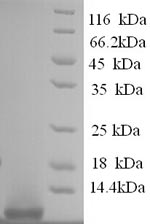Recombinant Human Pro-glucagon (GCG) is produced in a yeast expression system and contains the amino acid region 53-89. This partial protein includes an N-terminal 6xHis tag, which helps with purification and detection. The product achieves a purity level greater than 90%, as confirmed by SDS-PAGE analysis. Intended for research use only, this recombinant protein offers a reliable tool for various scientific applications.
Pro-glucagon serves as a precursor protein in the production of several hormones, including glucagon and GLP-1, which play key roles in glucose metabolism and homeostasis. This protein appears vital in research focusing on energy balance, diabetes, and metabolic disorders, since it participates in pathways that regulate these physiological processes. Understanding pro-glucagon's role may be crucial for advancing studies in endocrinology and metabolic research.
Potential Applications
Note: The applications listed below are based on what we know about this protein's biological functions, published research, and experience from experts in the field. However, we haven't fully tested all of these applications ourselves yet. We'd recommend running some preliminary tests first to make sure they work for your specific research goals.
Based on the provided information, recombinant human GCG is produced in a yeast expression system as a partial fragment (53-89aa) with an N-terminal 6xHis-tag. Pro-glucagon is a precursor protein that requires specific proteolytic processing to generate bioactive peptides such as glucagon and GLP-1. The fragment (53-89aa) corresponds to a portion of the pro-glucagon sequence but may not include all structural domains necessary for independent folding or bioactivity. While yeast expression systems provide eukaryotic folding machinery that can support disulfide bond formation and some post-translational modifications, the partial nature of the fragment raises concerns about its ability to fold correctly without the full protein context. Purity >90% by SDS-PAGE is determined under denaturing conditions and does not confirm native folding or bioactivity. No validation data (e.g., circular dichroism, activity assays) are provided. Therefore, the protein's folding status and bioactivity cannot be confirmed, and it is likely not bioactive as it represents an unprocessed fragment rather than a mature hormone.
1. Antibody Development and Validation Studies
This recombinant pro-glucagon fragment can be used as an immunogen for antibody generation, as antibody development primarily relies on linear epitope recognition, which is independent of folding status. The high purity and defined sequence support consistent immunization results. However, if misfolded, antibodies generated may not optimally recognize conformational epitopes of the full-length or properly processed pro-glucagon in biological contexts, limiting utility for functional studies. The His-tag facilitates purification but may also elicit tag-specific antibodies.
2. Protein-Protein Interaction Studies
If the fragment is correctly folded, the His-tag enables pull-down assays to identify binding partners, but the partial nature may lack key interaction domains present in full-length pro-glucagon. If misfolded, interaction studies may yield non-specific binding or fail to recognize genuine biological partners, compromising the validity of results. This fragment is unlikely to interact meaningfully with prohormone convertases or other processors due to its short length.
3. Structural and Biophysical Characterization
If properly folded, the fragment could be used for limited structural studies like NMR or circular dichroism to analyze local structure. However, if misfolded, structural data would misrepresent the native protein's conformation. The fragment's small size (37aa) may not reflect the full pro-glucagon structure, and the His-tag could interfere with detailed analysis.
Final Recommendation & Action Plan
This recombinant pro-glucagon fragment is unsuitable for functional studies due to its partial length and lack of validation; it should be used primarily for antibody development with caution, while other applications require full-length protein or validated constructs. The action plan includes: prioritizing antibody generation but validating antibodies against full-length pro-glucagon; avoiding interaction and enzyme substrate studies until a longer, validated fragment is available; for structural work, considering larger fragments or full-length protein expressed in mammalian systems for proper folding; and always including controls to ensure specificity. If bioactivity is needed, obtain commercially available mature peptides like glucagon or GLP-1 for reliable results.






